Colloquial Language: Diminutives and Augmentatives in Spanish

Mastering colloquial language in any language requires patience and experience. However, it's an effort worth making, as it encompasses all the linguistic variations that bring life and define the essence of the language.
In Spanish, the use of diminutives and augmentatives stands out as one of the main characteristics of daily communication. These suffixes not only modify the size of things but also serve as an excellent tool for understanding the linguistic culture of an entire community.
Join us as we explore what diminutives and augmentatives are, how they are formed, and their role as a means of expression in colloquial language.
Let’s get started!
What Are They?
In a nutshell, both diminutives and augmentatives are suffixes added to the end of certain words to modify or transform their meaning.
Diminutives are used to indicate that something is small or of low intensity and also to express affection or endearment. On the other hand, augmentatives indicate large size, exaggeration, and intensity.
Forming Diminutives and Augmentatives
For forming diminutives, suffixes like “-ito,” “-ita,” “-ico,” “-ica,” “-illo,” and “-illa” are commonly used:
- Examples with “-ito” and “-ita”: Perro = perrito, casa = casita.
- Examples with “-illo” and “-illa”: Pájaro = pajarillo, mentirosa = mentirosilla.
- Examples with “-ico” and “-ica”: Gato = gatico, puerta = puertica.
For forming augmentatives, the most common suffixes are: “-azo,” “-ón,” “-ote,” and “-ota”:
- Examples with “-azo”: Golpe = golpazo.
- Examples with “-ón”: Película = peliculón.
- Examples with “-ote”: Hombre = hombrote.
- Examples with “-ota”: Casa = casota.

Beyond Nouns
Although diminutives and augmentatives are primarily used with nouns, they can also be applied to other grammatical categories like adjectives. Here are some examples:
Adjectives and Diminutives:
- Feo → feíto (softening the harshness of the adjective).
- Example:
No pensé que tu novio fuera feíto.
- Example:
- Rico → riquito (a loving way to say something is delicious).
- Example:
¡Mamá, este desayuno está muy riquito!
- Example:
- Pequeño/a → pequeñito/a (something/someone of small size).
- Example:
Tu casa es pequeñita.
- Example:
- Bonito → bonitico (something/someone very cute).
- Example:
¿A quién quiero engañar? La verdad es que eres bonitico.
- Example:
- Caro → carito (a bit expensive).
- Example:
Ese reloj está carito.
- Example:
Adjectives and Augmentatives:
- Alto → altote (something/someone very tall).
- Example:
Oye, ¿cómo se llama tu amigo? El altote.
- Example:
- Grande → grandote (something/someone very big).
- Example:
¡Wow, ya eres un hombre grandote!
- Example:
- Gorda → gordota (very fat).
- Example:
Me sorprendió que estuvieras tan gordota.
- Example:
- Largo → largote (very long).
- Example:
Mi hermana tiene el cabello largote.
- Example:
- Ancho → anchote (something very wide).
- Example:
El camión era grande y anchote.
- Example:
Diminutives and Augmentatives to Express Time
These suffixes not only provide interesting nuances in communication but can also be used to express periods of time.
For very short time periods, diminutives like ratito/ratico, momentito/momentico, segundito, and minutito are used:
- Come with me; it will only be a ratito!
- I’ll be right back; I’m going for a walk for a ratico.
- Yesterday, I was at Raúl’s house for a momentito.
- Come here for a momentico, please.
- Wait for me here for a segundito.
- Give me a minutito, please.
For long time periods, the augmentative ratote is used:
- I waited for you for a ratote, and you never arrived.
- Get ready; we’ll be there for a good ratote.
General Tips
Colloquial language is significantly enriched by the use of diminutives and augmentatives. However, like any verbal resource representative of the linguistic culture of Spanish-speaking regions, their use should be moderate and adapted to the context. Here are some practical tips:
- Recognize the level of formality: Diminutives and augmentatives are usually used in informal contexts, like speaking with friends and family. Avoid using them in formal contexts, such as work meetings or conversations with strangers.
- Use them to express tenderness, affection, and admiration: Diminutives and augmentatives can soften communication or highlight admiration towards someone. For example, instead of saying “my daughter,” use “my hijita.” On the other hand, instead of saying “You’re good,” say “You’re a buenazo.”
- Avoid exaggeration: Learn to moderate the use of both. An excessive use of augmentatives can sound insincere or even sarcastic. Similarly, an excessive use of diminutives can give a childish tone.
In conclusion, diminutives and augmentatives are key elements that enrich colloquial language. Their use not only allows us to modify the size of things but also reflects the richness of the linguistic and emotional culture of Spanish-speaking communities. Mastering these suffixes is a valuable skill for any Spanish student, as it allows for the precise and effective expression of nuances and emotions.




